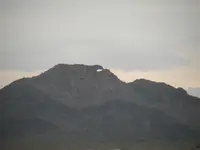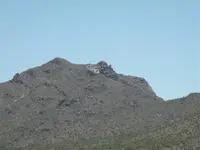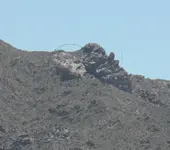You are using an out of date browser. It may not display this or other websites correctly.
You should upgrade or use an alternative browser.
You should upgrade or use an alternative browser.
A GUIDE TO VAULT TREASURE HUNTING (Condensed)
- Thread starter sandy1
- Start date
Crosse De Sign
Gold Member
- Joined
- Jun 19, 2013
- Messages
- 5,831
- Reaction score
- 5,931
- Golden Thread
- 0
- Location
- ~: Hell And Back :~
- Detector(s) used
- White's MXT ~ TM800 ~
- Primary Interest:
- Other
Pretty impressive U, wonder how many feet the hole is through the mesa?
If we all had teams of trusted workers, that could move that much material...
Bummer about the breakdown, your pics are cool though.
What are you using camera wise?
If we all had teams of trusted workers, that could move that much material...
Bummer about the breakdown, your pics are cool though.
What are you using camera wise?
Last edited:
Hmm. Now I'm beginning to connect some dots - explaining why you guys have been able to back-engineer all those mysterious empty holes you've found that may have some markings in common, and that may date back to the pre-Mexican War period . A number of treasure hunters have reported similar enigmas in the past.
I know that you will likely savage me for suggesting this (I expect it), but if you read a comprehensive history - especially the many available personal memoirs and journals of the French and American fur trappers in the CO-NM-AZ-CA region, much of it ca 1820s - you will find some very, very interesting facts. There is a lot of published information about this. One: virtually every river stream and intermittent drainage in this entire region was explored and trapped for beaver. Yes, even NM and AZ was rich in beaver before settlement, even desert areas where there was water - especially the entire length of the Colorado River. These guys worked either for the large fur companies directly or as groups of independent contractors for them. Many of the trappers wintered in Taos. Two: because of the weight and bulk of the prolific harvest of pelts, they quite frequently cached bundles of pelts as they worked their way along. The pelts were normally wrapped and buried in the ground to protect them from other animals, then retrieved later in the season for shipment. Three: the cache locations were marked with rock piles and other signs that would enable the trappers to easily retrieve them. They used common techniques of marking the caches so that they would be easier to locate later.
I know you want these empty holes to be Spanish treasure vaults, but what you might have was even more valuable during the time period. Now at least some of your allegations make sense to me. The one thing that always bothered me about your claims was the alleged great number of mine caches. For what it's worth, you might look at this post I made on another thread. You can believe as you wish, but there are facts available that contradict the wishes of many believers of treasure legends. http://www.treasurenet.com/forums/lost-dutchman-s-mine/538428-cave-gold-bars.html#post5479817
One of the first things I studied, after locating the site I study, was the fur trade. Mainly because there are no gold or silver deposits close to where I live. Some of the early traders would have 15-20 thousand dollars worth of trade goods. I even considered the possibility that cache sites, for trade goods, were used multiple times, at the same location, and might have started out as just two or three symbols and more symbols were added as time passed and the objects in the caches changed. As an example, a site might have been used to cache furs for ten or fifteen years. Maybe three rock formations were used to form a triangle with a perimeter of a half mile and the furs were hidden somewhere on that perimeter. That triangle could probably be used for many years with the cache site changing along the perimeter. Maybe gold is discovered in the area so a couple of heart symbols were added to the cache site. As the years passed, perhaps the cache site was used to hide bullion along a stagecoach trail, and maybe a few owls were added within the large triangle, forming a smaller triangle, within the big one. The possibilities are endless. The triangles could get smaller or bigger depending on changing circumstances.
I did read about one of the Chouteaus burying trade goods in Spanish territory and then losing them when the Spaniards followed the symbols to the cache.
I am using the nikon coolpix P80 its an older camera but has never let me down.
I haven't been up to that last hole but if its anything like this one (pictured below) its a good 10 feet thick which incidentally is marking another mountain range with treasure vaults along it.
View attachment 1476894
There is an eye shaped hole here. Whoever put it there, chipped away at one side, until they got to the thickness they wanted, and then they went to the other side of the rock and chipped out the shape of the eye and the angle they wanted to look through, to the northeast. As you look toward this mountain, what direction are you looking?
The only one I can say for sure is the Colorado, and they put storages on mountains all up and down the Colorado, all you have to do is look for the man made Holes in the mountains that you would see going along the colorado,If anybody is going to Vegas from Kingman there is one on the left between K and V and anybody going from Quartzite to Yuma there is another one on a peaked mountain between those to towns The holes are used to show the mountain ranges with storages. If memory serves me at the Peralta trailhead in the Superstitions there is a hole that you can see from the parking lot also.
Thanks Sandy.
Here is one of my posts from Randy Bradford's thread about Treasure Mountain, Colorado. Father Aulneau was a Jesuit priest and he died in a massacre on what is now the U.S.-Canadian border, during the 1730's.
I've posted a couple links, in the past about Father Aulneau and Johnathan Carver. Here's an excerpt from Father Aulneau where he describes a journey from Lake of the Woods to a destination 300-400 miles to the southwest. That distance and direction would have put him in Colorado.
I shall leave that post only in the spring, to journey on three or four hundred leagues beyond, in quest of the Ouant Chipouanes, so that my course then will be southwest.
Such, Reverend Father, is the route I shall follow towards an objective point which you see is very indefinite and uncertain, since all we know about it is founded on the reports of other Indians, who, for the most part, have little scruple in speaking differently from what they think.
If what they add concerning the place where the Ouant Chipouanes dwell be true, I should say that these cannot be very far from California, for, if we are to believe their reports, the Ouant Chipouanes dwell on the shores of a great river where there is an ebb and flow in the stream, which would go to show that the sea cannot be very far off. It is not easy to determine what river this is. I am led to surmise, however, that it is no other than the great river which Father King, a German Jesuit, mentions in the map which he traced of the regions lying to the north of California, and which he calls the Rio Colorado de Norte. Seethe fifth collection of the Lettres Edifiantes*
Here's the excerpt from Carver's journal.
(31) My reaſons for adopting this ſuppoſition are ... thirdly from their inveterate hatred to the Spaniards. Some of them informed me that they had made many excurſions to the ſouth-weſt, which took up ſeveral moons. An elderly chief more particularly acquainted me, that about forty-ſix winters ago [1720], he marched, at the head of fifty warriors, towards the ſouth-weſt, for three moons. That during this expedition, whilſt they were croſſing a plain, (32) they diſcovered a body of men on horſeback, who belonged to the Black People; for ſo they call the Spaniards. As ſoon as they perceived them, they proceeded with caution, and concealed themſelves till night came on; when they drew ſo near as to be able to diſcern the number and ſituation of their enemies. Finding they were not able to cope with ſo great a ſuperiority by daylight they waited till they had retired to reſt; when they ruſhed upon them, and after having killed the greateſt part of the men, took eighty horſes loaded with what they termed white ſtone. This I ſuppoſe to have been ſilver, as he told me the horſes were ſhod with it, and that their bridles were ornamented with the ſame. When they had ſatiated their revenge, they carried off their ſpoil, and being got ſo far as to be out of the reach of the Spaniards that had eſcaped their fury, they left the uſeleſs and ponderous burthen, with which the horſes were loaded, in the woods, and mounting themſelves, in this manner returned to their friends. The party they had thus defeated, I conclude to be the caravan that annually conveys to Mexico, the ſilver which the Spaniards find in great quantities (33) on the mountains lying near the heads of the Coloredo River: and the plains where the attack was made, probably, ſome they were obliged to paſs over in their way to the heads of the River St. Fee, or Rio del Nord, which falls into the gulph of Mexico to the weſt of the Miſſiſſippi."[SUP]1[/SUP][SUP]
Aulneau and Carver both mention the Colorado River. 300 leagues, at 2.75 miles per league, would have put Aulneau close to the head of the Colorado River. But Carver's story is kind of surprising because he mentions Spanish silver mines being close to the headwaters of the Colorado. Eagle River, a tributary of the Colorado, has its source in a silver producing area of Colorado. He also mentioned that the mule train was probably going toward the headwaters of the Rio Grande and the Santa Fe River, which meant that Carver had a good knowledge of New Mexico even though he had never been there. Also, his comment about the men of the mule train belonging to the Black People was interesting.Aulneau was a Black Robe. Could there have been a Jesuit presence in the silver producing area close to the head of the Colorado River.[/SUP]
sandy1
Bronze Member
- #1,187
Thread Owner
Here is My Theory, much of the mining here was not done by the Spanish but a much older civilization that inhabited the southwest, and just as the Spanish did to the Incas and the Aztecs they would loot from this older Indian Type Civilization, this would include Ancient Tombs that they found and whatever treasures that were already buried in them.
Here is My Theory, much of the mining here was not done by the Spanish but a much older civilization that inhabited the southwest, and just as the Spanish did to the Incas and the Aztecs they would loot from this older Indian Type Civilization, this would include Ancient Tombs that they found and whatever treasures that were already buried in them.
That's real interesting and a theory shared by others. Was the Indian Type Civilization actually Native American or some ancient civilization from a different part of the world. The reason I ask is because some of the setups described in the southwest are similar to ancient Phoenician religious sites. That doesn't mean that the Phoenicians set them up but pottery shards or other surface artifacts, found around these tombs, could help date the site and let us know who was there. Here are a couple of examples. You have written about the King's throne that can be seen from a long way off. The Phoenicians had a similar stone throne that they left empty in honor of one of their Gods. Also, you and others have described large animal shaped rock formations, here is a link about large animal shaped sculptures found in Spain.
https://en.wikipedia.org/wiki/Verraco
If the Spanish knew of such sculptures in Spain, they would be able to recognize them in the New World.
sdcfia
Silver Member
Here is My Theory, much of the mining here was not done by the Spanish but a much older civilization that inhabited the southwest, and just as the Spanish did to the Incas and the Aztecs they would loot from this older Indian Type Civilization, this would include Ancient Tombs that they found and whatever treasures that were already buried in them.
We know it wasn't the Spanish. We also have evidence that several non-native cultures visited, explored and possibly exploited resources in North America - the 2000 BCE and later Chinese from California to the Rio Grande, the 900 BCE Phoenician seafarers in the Rio Grande Valley, the 1000 BCE and later Norse all over New England and the upper midwest, 1300 CE Basque fishing fleets on the east coast, the 800 CE Roman colony in Arizona, the various white visitors who taught and joined native cultures all over the south and southeast. Oh, and Columbus in 1492. Yeah, North America may have been a pretty well-known place to much of the world over the centuries. However, most all of this diffusionist evidence is ignored, trashed, or laughed at by "real historians" - but then, those guys have their careers to protect too.
Did these early travelers locate vast stores of precious metals and carve entire mountains to mark their locations? Mineral exploration - likely noted with some exploitation, IMO. Carve mountains for signs - not necessary, IMO.
sandy1
Bronze Member
- #1,191
Thread Owner
There is nowhere near enough evidence that all the carvings (tons of shaped and moved Boulders etc.) where done by any culture from another country, this is why I said a Native Culture as I believe they had to live here to do so much work.
The Religious carvings of the crosses and Jesus were definitely from the Europeans as were the Lion and Elephant Carvings but many of the huge markers are not European.
The Religious carvings of the crosses and Jesus were definitely from the Europeans as were the Lion and Elephant Carvings but many of the huge markers are not European.
Crosse De Sign
Gold Member
- Joined
- Jun 19, 2013
- Messages
- 5,831
- Reaction score
- 5,931
- Golden Thread
- 0
- Location
- ~: Hell And Back :~
- Detector(s) used
- White's MXT ~ TM800 ~
- Primary Interest:
- Other
I have seen what is very possibly of the Phoenician, or Carthaginian
type of carvings, that appear to be of the nature of art that they did,
of goddess & fertility worship. Since the subject's been brought up...
Probably are responsible for teaching human sacrifice also.
http://www.google.com/url?sa=t&rct=...a.html&usg=AFQjCNGpxttwOf-o2BDAEiJVafkEKX-beg
type of carvings, that appear to be of the nature of art that they did,
of goddess & fertility worship. Since the subject's been brought up...
Probably are responsible for teaching human sacrifice also.
http://www.google.com/url?sa=t&rct=...a.html&usg=AFQjCNGpxttwOf-o2BDAEiJVafkEKX-beg
Last edited:
Backwoodsbob
Silver Member
- Joined
- Nov 12, 2013
- Messages
- 2,707
- Reaction score
- 1,936
- Golden Thread
- 0
- Primary Interest:
- All Treasure Hunting
Cross, what do you mean about the fertility worship? Have you seen it on the stone workings?
Sent from my SM-G900T using Tapatalk
Sent from my SM-G900T using Tapatalk
Crosse De Sign
Gold Member
- Joined
- Jun 19, 2013
- Messages
- 5,831
- Reaction score
- 5,931
- Golden Thread
- 0
- Location
- ~: Hell And Back :~
- Detector(s) used
- White's MXT ~ TM800 ~
- Primary Interest:
- Other
Bob, I suspect so.
Was first pointed out to me, one of their goddess' (Tannit)
by Oro in some pics showed. I looked into it, & later observed
other stuff. There are some unusual things, I don't think got
destroyed by potential later hunters, but ignored or just
mingled in with, are not Spanish.
Was first pointed out to me, one of their goddess' (Tannit)
by Oro in some pics showed. I looked into it, & later observed
other stuff. There are some unusual things, I don't think got
destroyed by potential later hunters, but ignored or just
mingled in with, are not Spanish.
Last edited:
sandy1
Bronze Member
- #1,196
Thread Owner
Here is an article that I read many years ago. I will explain the point after enough people have read it.
Freddy Crystal and the Search for Moctezuma's Treasure
Freddy Crystal and the Search for Moctezuma's Treasure
Last edited:
sdcfia
Silver Member
There is nowhere near enough evidence that all the carvings (tons of shaped and moved Boulders etc.) where done by any culture from another country, this is why I said a Native Culture as I believe they had to live here to do so much work.
The Religious carvings of the crosses and Jesus were definitely from the Europeans as were the Lion and Elephant Carvings but many of the huge markers are not European.
Deception 1: create "native appearing" petroglyphs carrying proprietary information. Place said carvings amid genuine native petroglyphs.
Deception 2: use religious themes with proprietary meanings to associate carvings with a "likely source" - European Catholics
sdcfia
Silver Member
I would have liked to have seen pictures of actual carvings out of rock that support the Phoenician idea of mining here in america (something that matched what they had in their homeland)
I posted photos of numerous "Phoenician" appearing carvings found in New Mexico's lower Rio Grande Valley a couple years ago in other threads - the Caballo Mountain/Victorio Peak threads, as I recall. I also seem to recall providing a link to a very interesting book that discussed the so-called "Decalog Stone" near Los Lunas NM. The most interesting part of the book wasn't the stone itself (paleo-Hebrew alphabet), but the site plan of the fortification ruins on the mesa top above the stone, and the apparent incised star map used to speculate on the mesa's time of occupation. If you're interested, sort through my past posts.
Backwoodsbob
Silver Member
- Joined
- Nov 12, 2013
- Messages
- 2,707
- Reaction score
- 1,936
- Golden Thread
- 0
- Primary Interest:
- All Treasure Hunting
The Jesuits were educated enough to hide their work by using that cultures work. Making one thank differently
Sent from my SM-G900T using Tapatalk
Sent from my SM-G900T using Tapatalk
Backwoodsbob
Silver Member
- Joined
- Nov 12, 2013
- Messages
- 2,707
- Reaction score
- 1,936
- Golden Thread
- 0
- Primary Interest:
- All Treasure Hunting
At my site there are Aztec looking figures and it east of the Mississippi. I know its a Jesuit site. So I just figured they use all types of cultural input in their work. Just the way they have hidden it in plain site says a lot. Using the sun and shadows also to bring out a message is brilliant.
Sent from my SM-G900T using Tapatalk
Sent from my SM-G900T using Tapatalk
Similar threads
Users who are viewing this thread
Total: 2 (members: 0, guests: 2)




